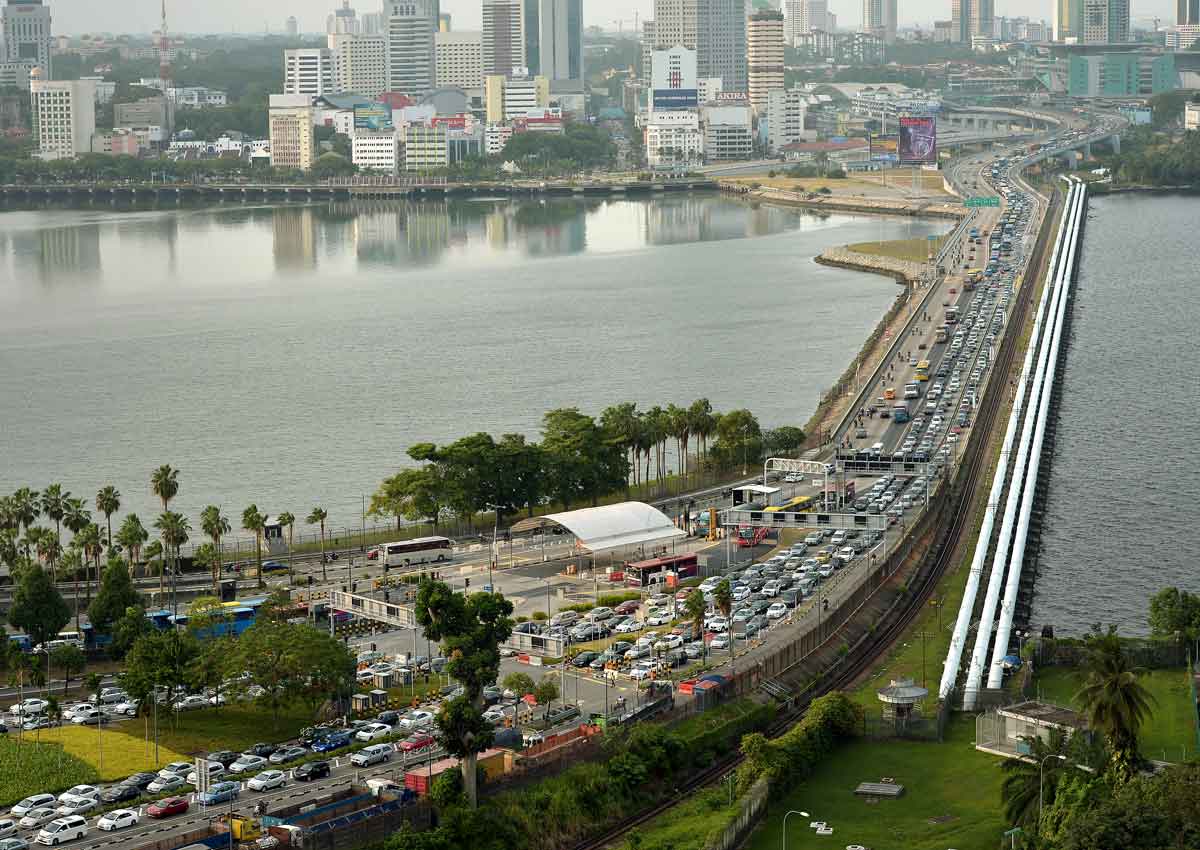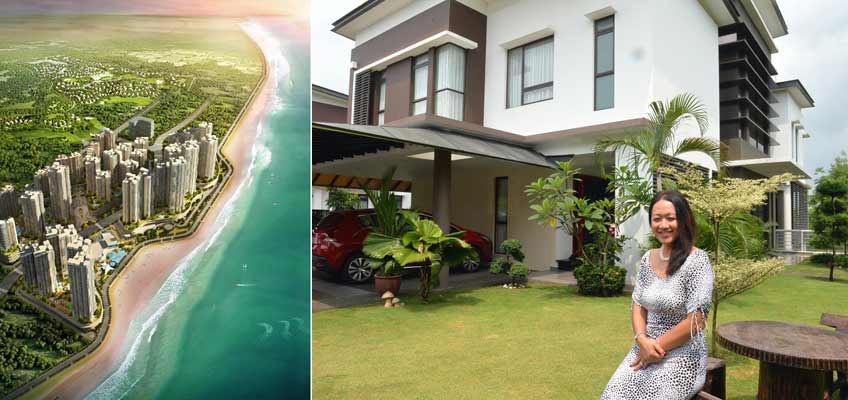According to a 2014 estimate by the Johor-Singapore Community Care Association, about 5,000 Singaporean families have set up home across the Causeway.
Some are retirees, such as 68-year-old Amy Tan, who moved in 2014 after her husband retired. Others, such as Mr Ang Khartono Jamil Hanmin, 35, who works in events project management, still work in Singapore, but have chosen to live in Johor Baru and commute between the two cities daily.
Mr Ang says one could buy a terrace house in Johor Baru for the price of a three-room HDB flat in Singapore.
Cost of living was also the main reason behind Ms Noraini Mokhtar’s move. The 47-year-old decided to become a stay-home mum five years ago. Bringing up six children on one income, she and her husband decided that living in Johor Baru would be more viable.
Cheaper cars are another draw. A BMW 320i Sedan Sport retails at $193,800 (after $5,000 CEVS rebate) in Singapore. Its equivalent costs RM231,800 (S$78,270) in Malaysia – about 60 per cent cheaper.
A 2.4-litre Honda Odyssey EXV costs $158,999 in Singapore and RM248,288 in Malaysia – almost half the price.
Singaporeans who take up the Malaysia My Second Home (MM2H) Programme are allowed to import one car into Malaysia or buy a locally made car with duty and sales tax exemptions.
In addition to the already substantial differences in car prices, these tax exemptions mean even bigger savings.
Moreover, when one buys a car in Malaysia, one can keep it for as long as one wishes, unlike in Singapore, where the car’s certificate of entitlement (COE) has to be renewed every 10 years.
Cars are cheaper to maintain as well. The road tax in Johor Baru is RM200 a year for a 1.8-litre car, compared to S$929 in Singapore. Insurance premium for the same car is less than RM2,000 a year – before no-claim discount.
The pump price for 97-octane petrol is RM2.05 a litre, which works out to be about S$0.70 – less than half the price of the lowest- grade fuel in Singapore.
Read also: Johor Sultan: S’poreans will live in Johor and work in S’pore
But there is a big catch. While cars are cheaper in Malaysia, Singaporeans are not allowed to use or keep any foreign-registered vehicle in Singapore. This is a measure by the Land Transport Authority to control the car population in Singapore.
It also plugs the loophole for anyone attempting to bypass Singapore’s COE and other vehicular taxes by buying and registering a car in Malaysia and using it in Singapore.
For those who live in Johor Baru and need to return to Singapore frequently, this is a big consideration.
But Mrs Tan says a Land Transport Authority (LTA) officer told her over the telephone that Singaporeans living or working in Johor Baru can apply for a limited exemption to this rule. This means they can drive Malaysian-registered vehicles to Singapore for an unspecified number of days a year. The LTA would not comment on this when asked.
Whether it is with a Malaysian or a Singapore-registered car, commuting between the two cities may well be the most challenging aspect of living in Johor Baru.
Mrs Tan and her husband used to shuttle between the two cities a few times a week, but started cutting back on unnecessary trips after the vehicle entry permit rates were raised in August 2014.
About a year ago, the couple traded their Singapore-registered car for a Malaysia-registered vehicle under the MM2H scheme. They now take the train across the Causeway about once a week.
Previously, they would leave home at about 6am. Their drive to Singapore took about an hour on average.
It is the same for Ms Noraini. Her children attend school in Singapore and she does the school run on most days. When she first moved to Johor Baru, she would leave home at about 6am and reach her daughter’s school at 7am.
But she has observed that the Johor Baru-Singapore traffic volume has increased in recent months.
“Since early last year, I have had to leave home earlier, at about 4.45am, to beat the jam. On Mondays when the traffic is heavier, I must reach the Checkpoint before 5.30am to avoid being stuck in a two-hour jam,” she says.
She adds that once, she set off at 4.45am, but reached her destination at 8am – a one-way commute of more than three hours.
She relies on transport apps and webcams from sites such as onemotoring.com, causewayjam.com and jalanow.com to monitor the traffic situation to help her decide what time to leave home and whether to take the Causeway or the Second Link.
After taking her children to school, she runs errands, visits friends or goes to the library before picking them up to drive home at about 3pm. The trip back to Johor Baru is relatively smooth and she is home in about 30 minutes.
Race driver Denis Lian, 44, moved to Johor Baru in 2008 and drove to work in Singapore until 2013.
“I would leave home at 8.45am and be at the office by 9.30am. It was a very convenient arrangement,” he recalls. “You only had to be aware of public holidays or school holidays, then you would plan to leave at least an hour earlier.”
After work, he would get to the Second Link by about 5pm. It usually took him 20 minutes to clear immigration and customs. He stayed back to have dinner with friends on Fridays, when the jam is usually bad. During school holidays or public holidays, the journey to Johor Baru can take two hours or more.
Read also: Wise to buy Malaysian property now?
Like Ms Noraini, he has also noticed that the traffic seems to have slowed considerably over the years.
Mr Ang commutes daily between Johor Baru and Singapore via the Second Link. He typically spends between 30 minutes and an hour waiting in the immigration queue. He drops his wife off at the office and his one-year-old daughter at her caregiver’s place before going to work.
He and his family drive back to Johor Baru after 8pm. The return trip at that time usually takes about an hour.
Going by these examples, it would seem that Singaporeans living in Johor Baru have to put up with commutes of more than two hours regularly if not daily. The return trip takes about an hour on average. So they can end up spending three hours on the road a day.
Those who have chosen to live in Johor say it is par for the course, though.
Mr Ang says with a shrug: “If I were in, say, Australia and I lived in the suburbs and worked in the city, my daily commute would probably take at least an hour too.”
Mrs Tan adds: “The travelling time is something that Singaporeans have to accept as part of living in Johor Baru.”
Read also: S’porean students drawn to Johor’s EduCity
•The writer contributes to Torque, a motoring monthly published by SPH Magazines.

This article was first published on May 28, 2016.
Get a copy of The Straits Times or go to straitstimes.com for more stories.

















































